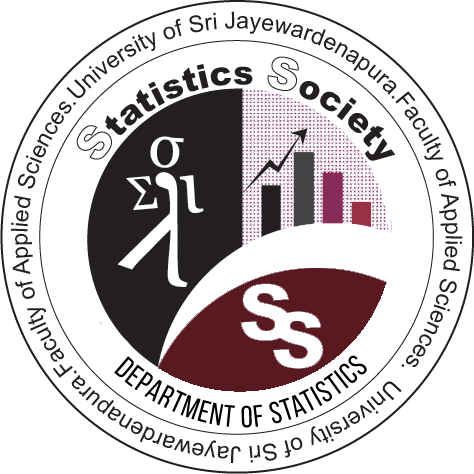The Statistics Society of University of Sri Jayewardenepura has a proud history of over a decade being established in 2009. Having the society being initially formed by a group of students, today it drives with the sole purpose of encouraging and supporting students to learn Statistics, not just theoretically, but also in a practical manner that would supplement the education they received from the university. The society also provides opportunities for students to interact with the industry which enables students to attain various skills that’ll contribute to corporate, social as well as personal growth of students.
The Statistics Society is propelled with the Vision of: “To improve awareness and facilitate education of Statistics in Sri Lanka at all levels.”
The Missions of the society are:
- To act as a bridge between school, university and the industry while adhering to industry expectations and giving back to the community.
- To provide effective programs in support of students studying Statistics in schools.
- Collaborate with the industry to provide an understanding of the industry expectations and to promote the importance of Statistics to students.
- To promote an active, engaged and diverse membership and to improve the lecturer-student relationship.
All academic staff members are presented with the honorary membership of the society while the student membership is open for all students studying statistics under the Department of Statistics.Annually, the office of the society renews with the hope of catering the goal of the society by organizing purposeful and paramount events such as the Statistics Day, Workshops, Guest Talks, Statistics Night and CSR Projects.
Annual Reports
Selected Articles on popularizing Statistics written by members of the society
Predicting the playing 11’s of the ICC World Test Championship Final 2021
-
Authors: Savindu Kodikara, Charith Eranda, Minindu KarunasenaEditors: Janith Wanniarachchi, Thisaakhya JayakodyThe ICC World Test Championship finals are coming up on the 18th of June and the two teams facing the finals are up for a challenge in selecting their best players for the match in Rose Bowl, SouthamptonIn this article we explore how statistics can help in deciding the composition of the two teams. Data was collected based on 4 criteria. Namely, the overall performance in test cricket, performances against the respective opponents, performances in test cricket at England, performances in the world test championship. The reasoning for the selection of the above criteria is explained in the article . Data was collected through espncricinfo website and a descriptive analysis was done to predict the final 11s.Read more on predicting the playing 11’s of the ICC World Test Championship Final 2021 from the link below.
Remember 2012, the supposed year of Doomsday?
Authors: Rashmini Rathnaweera, Rashmi Jayasekara, Chalani Pradeepika
2012 marked the end of one of the cycles of the ancient Mayan Calendar but, with a scientific perspective, 2012 was the year that the newly discovered planet Nibiru was supposedly headed towards Earth, entailing a catastrophic collision. Despite all the speculations, 2012 ended up being a typical year but the data suggests otherwise. When looking at the past statistics of the annual population growth of Sri Lanka from 1960 – 2018, there is a sudden atypical drop in 2012. As intriguing as it may seem, when further investigated as to what this actually implied, it was found that such phenomena are more commonly known as population shocks; a sudden reduction in a human population size caused by many factors.
Sri Lanka has been battling the COVID-19 pandemic since 2020 and the country is yet to recover from it. So, it led to the exploration, what sort of a population shock will be caused by COVID-19? This was quantified through an Excess mortality measure known as P-score. There are two components to the P-score value; total deaths that would have occurred without COVID-19 and total deaths due to COVID-19, assuming all other conditions remain the same. The former component was calculated through a time series ARIMA model fitted to total annual deaths in Sri Lanka from 1948-2003 and the model was validated through total annual deaths in Sri Lanka from 2004 to 2018. The latter component was obtained with the aid of the COVID-19 deaths predicted and published by the Institute of Health Metric and Evaluation (IHME).
Accordingly, the forecasted excess mortality for Sri Lanka for the year 2020 and 2021 comparative to the last 5 years is 9% and 17%. There is almost double the increase in mortality in just one year.
Find it interesting?
Visit the following link for a more detailed description:
https://statsociety-usjp.medium.com/remember-2012-the-supposed-year-of-doomsday-2d7c3d5481e7


